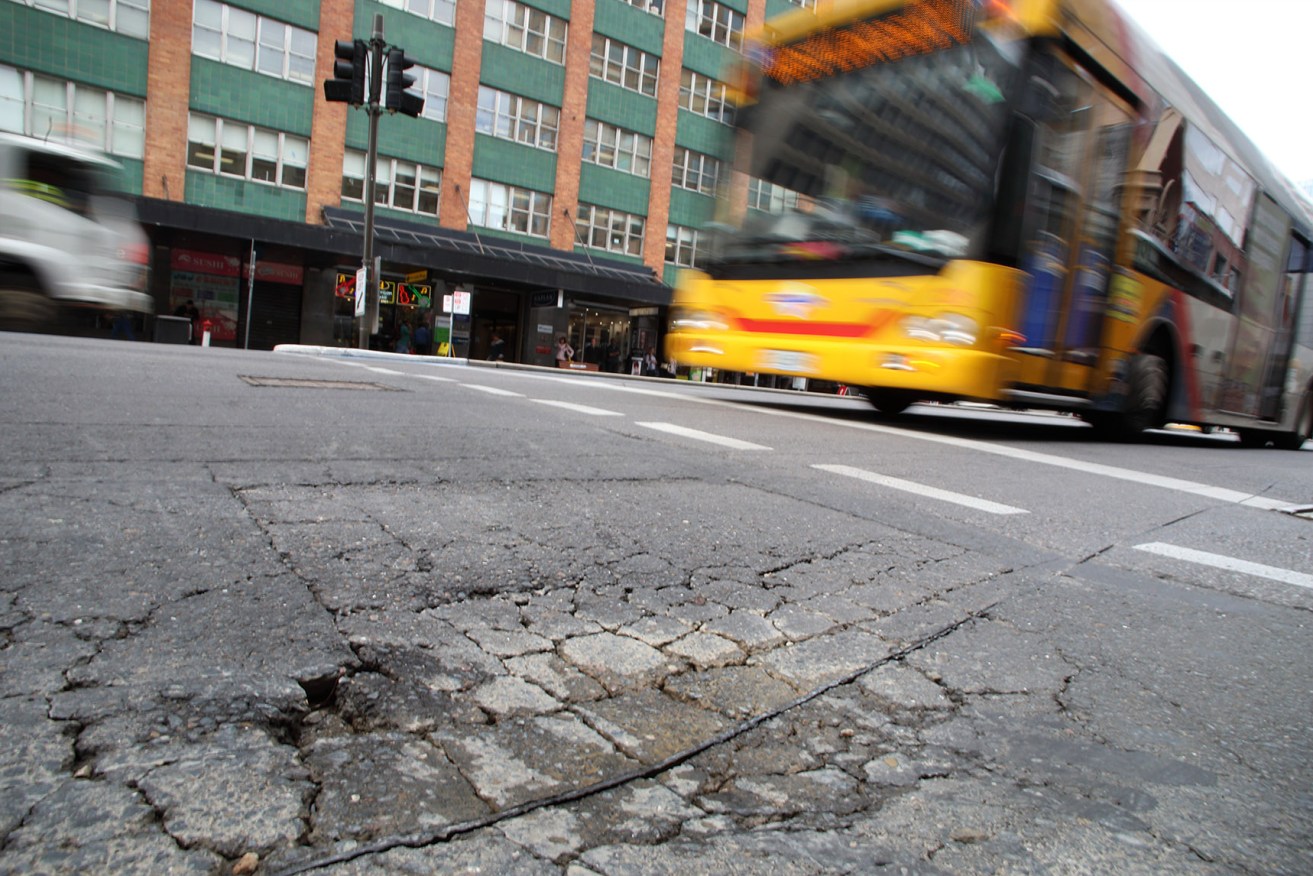Hundreds more O-Bahn buses to hit “deteriorating” Grenfell St
A redeveloped O-Bahn will start sending hundreds of buses down an unimproved Grenfell Street from next week, despite years of warnings over the city corridor’s dilapidated, “rapidly deteriorating” condition.


Hundreds more 18-tonne buses will contribute to the deterioration of Grenfell Street when the newly redeveloped O-Bahn opens this weekend. Photo: Tony Lewis / InDaily
The State Government is rejecting any responsibility for upgrading Grenfell Street, which, infrastructure experts have consistently argued over the past several years, is in need of a major overhaul.
Grenfell Street, owned and maintained by the Adelaide City Council, is set to carry hundreds more buses – the daily total rising to about 2600 buses, each weighing about 18 tonnes – east-west across the CBD through the O-Bahn tunnel.
Transport Minister Stephen Mullighan told InDaily: “Grenfell Street is under the care and control of the City of Adelaide, which is responsible for its maintenance and any upgrades.”
But the council has long argued that the Government’s buses are doing the damage and that it should contribute significant funding to a major rebuild of the road.
Council director of operations Beth Davidson-Park said the council was in high-level discussions with the Government about a potential redevelopment of Grenfell and Currie streets and that she was “optimistic” about the prospects of a funding partnership.
The Federal Government considered a major upgrade the streets – which form Adelaide’s busiest bus corridor – as part of its own O-Bahn redevelopment proposal as early as 2011 (the project was abandoned as a result of the budget impact of that year’s flooding in Queensland).
In 2014, city council transport experts argued the bitumen on those roads needed to be replaced – potentially with reinforced concrete – because “extreme loadings (the weight of buses) result in the road surfaces being continually deformed and the structural integrity of the whole pavement is compromised”.
In March 2015, council staff reported: “Currie and Grenfell Streets are deteriorating rapidly as a result (of) bus impacts” – a warning they passed onto the State Government.
Following each of the past two state budgets, Lord Mayor Martin Haese has expressed his disappointment at Government’s unwillingness to commit funding to redevelop Grenfell Street.
Though neither level of government has made any commitment of funding for a major overhaul of Grenfell Street, Davidson-Park said there was hope of a “positive outcome”.
She told InDaily: “We’re having good early discussions with the State (Government) around the future of Grenfell.”
“I’m really confident of a good outcome,” she said, adding that the “high-level” discussions between the council and the Government had been ongoing “for a number of months”.
“We’re quite confident that we’ll get some good outcomes out of those discussions over time,” she said.
Davidson-Park accepted that the road was the council’s responsibility to maintain and that it was “in a worse state now that it was in 2015”.
But she insisted the council’s upkeep of the road had been adequate and “we are keeping it to safe standards”.
“We’ve actually increased our investment in maintenance … since 2014 and we’ll continue that maintenance regime,” she said, adding “it will need some significant upgrades in the future”.
She said the degeneration of the road, and the need for maintenance works, was likely to increase with about 10 per cent more buses travelling along it each day.
She said buses caused damage not only by travelling over the bitumen, but by causing vibrations at a stop, when letting passengers on and off.
Haese was unavailable for comment, but Deputy Lord Mayor Sandy Verschoor told InDaily this morning that “both (levels) of government have been trying to work to resolve it”.
“I don’t think it’s a blame game … everybody wants the best outcome for the city” she said.
“I very much hope that in the next state budget there’s a decent allocation to help us.”
Correction: Late Friday afternoon, several hours after Davidson-Park spoke to InDaily and we published this story, the City Council clarified that the 10 per cent increase in buses travelling along Grenfell Street associated with the O-Bahn had already occurred – diverted from North Terrace to Grenfell Street in early October, when the tram extension works began. The same number of buses each day – around 2600 – will travel through the O-Bahn into Grenfell Street as travel along East Terrace into Grenfell Street now.




